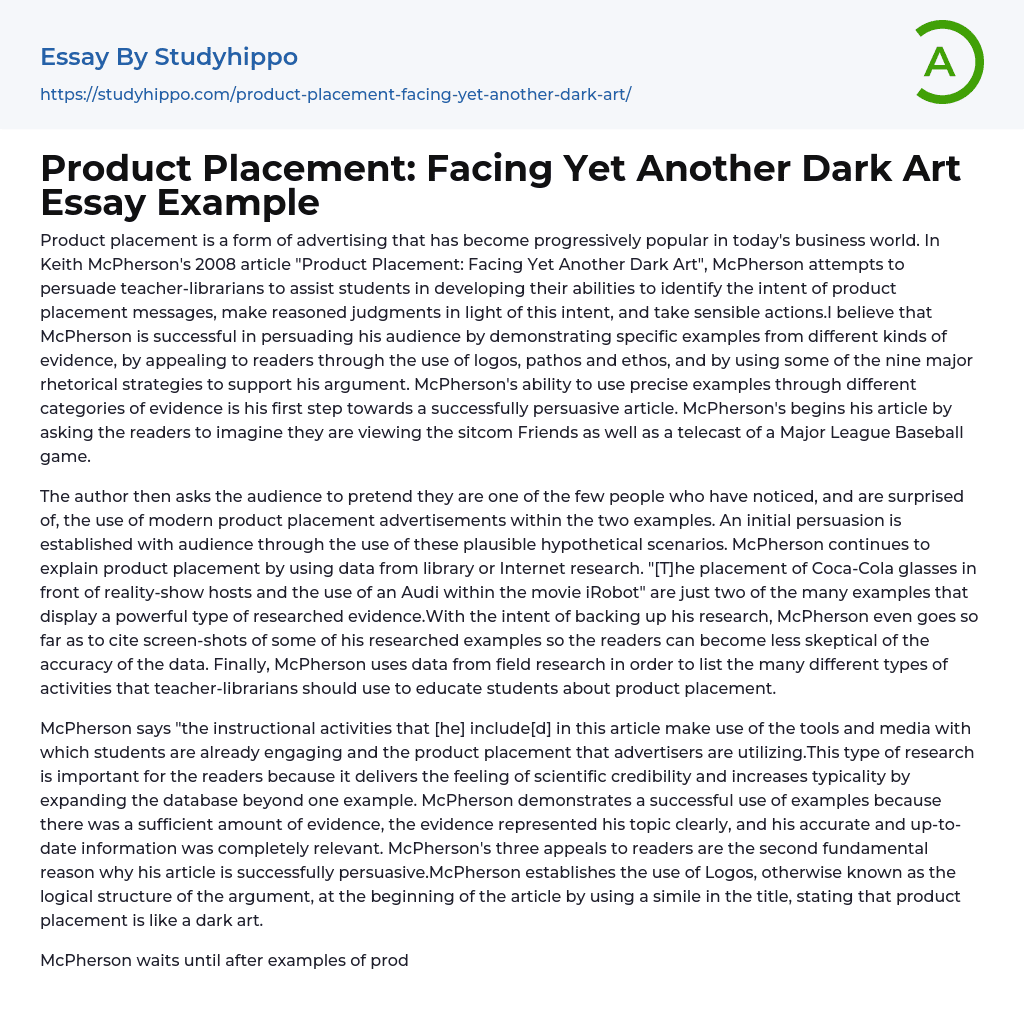

Product Placement: Facing Yet Another Dark Art Essay Example
Keith McPherson's 2008 article "Product Placement: Facing Yet Another Dark Art" discusses the increasing popularity of product placement as a form of advertising. In the article, McPherson calls on teacher-librarians to help students develop their ability to identify the intent behind product placement messaging, make informed judgments, and take appropriate actions. Through the use of logos, pathos, and ethos, as well as employing various rhetorical strategies, McPherson successfully persuades his audience by presenting specific examples from different categories of evidence. He begins his article by asking readers to imagine watching popular sitcom Friends and a Major League Baseball game.
The author invites the audience to imagine themselves as someone who has noticed and is surprised by the use of modern product placement advertisements in two examples. The use of these plausible hypothetical scenarios serves to establish initial persuasion. McPherson th
...en supports his explanation of product placement by using data obtained from library or Internet research. He provides various examples of powerful researched evidence such as the placement of Coca-Cola glasses in reality-show hosts' view or Audi in the movie iRobot. To support his research and convince readers of its accuracy, McPherson includes screen-shots of some of his researched examples. He then draws on field research to enumerate different activities that teacher-librarians could use to educate students about product placement.
According to McPherson, utilizing the tools and media with which students are already engaged, as well as incorporating product placement used by advertisers, is crucial for successful instructional activities. This methodology increases typicality by expanding databases beyond a single example and provides scientific credibility. McPherson also effectively utilizes relevant evidence to convey his topic clearly. The three appeals
to readers, including Logos or logical structure of argument, further enhance the persuasiveness of his article. In fact, McPherson uses a simile in the title to establish the use of Logos from the beginning, likening product placement to a dark art.
After giving examples of product placement, McPherson reintroduces his argument by emphasizing its significance: "Product placement is important, as are the actions that we choose to take against such deceptive advertising." His argument is structured in a way that allows readers to fully comprehend the subject matter once he explains it. To support his examples and clarify product placement, McPherson references various visual images, enabling readers to better understand his message. By presenting tangible evidence, McPherson's credibility, or ethos, is effectively strengthened as readers can witness what he has observed.
By providing a variety of examples from field research, McPherson bolsters the credibility of his argument and enhances the emotional appeal, also known as pathos, to the audience. One such example includes referencing the movie E. T.
From video games to music videos, the movie E.T. can evoke nostalgia for some, while appealing to a broader audience. Moreover, the title of the argument, "Product Placement: The Dark Art," contributes to its pathos by creating a negative association with product placement.
In his article, McPherson skillfully employs the three appeals to readers, making his arguments and evidence highly persuasive. He uses key rhetorical techniques to encourage viewers to embrace his ideas. For instance, McPherson employs narration at the beginning of his article to engage readers, urging them to imagine themselves taking part in a hypothetical event. This helps all readers feel connected to the scenario being narrated.
Throughout the article,
McPherson employs several rhetorical strategies to explain product placement, its methods, and how to avoid being controlled by it. One such strategy is the use of description, where McPherson defines product placement as paid exposure of products in visual and auditory content such as TV shows, films, and video games. Another strategy employed is comparison, where McPherson contrasts overt commercials with covert product placement to highlight critical differences. Furthermore, McPherson uses cause-and-effect analysis to suggest exercises that teacher-librarians can perform with their students to combat product placement messages. These exercises help students understand how they might react to different messages and what other activities they should undertake as a result.
Keith McPherson utilizes various writing strategies in his article "Product Placement: Facing Yet Another Dark Art". These strategies include the use of specific examples, the three appeals to readers, and major rhetorical strategies. The effects of these exercises provide readers with a better understanding of McPherson's goals and enhance his argument, making his article appear more genuine. Ultimately, McPherson's use of all rhetorical strategies transforms students into active masters rather than passive servants.
Despite the omission of the negative impacts of not learning to identify, judge, and act on product placement messages, McPherson's article presents a convincing argument backed by evidence and analysis. His writing is praiseworthy overall.
- Sales Promotion essays
- Advertising campaign essays
- Advertisement essays
- Advertising essays
- Anheuser-busch essays
- Audience Theory essays
- Brand essays
- Brands essays
- Competitor Analysis essays
- Consumer essays
- Detergent essays
- Marketing Management essays
- Marketing Mix essays
- Marketing Plan essays
- Marketing Research essays
- Marketing Strategy essays
- New Product Development essays
- Point Of Sale essays
- Price essays
- Procurement essays
- Product essays
- Product Differentiation essays
- Product Placement essays
- Promotion essays
- Promotion And Marketing Communications essays
- Research Design essays
- Retailing essays
- Trademark essays
- Acceptance essays
- Age Of Enlightenment essays
- Child Observation essays
- Confucianism essays
- Conscience essays
- Critical Reflection essays
- Destiny essays
- Determinism essays
- Empiricism essays
- Environmentalism essays
- Epistemology essays
- Ethics essays
- Ethos essays
- Existence essays
- Existentialism essays
- Fate essays
- Free Will essays
- Functionalism essays
- Future essays
- Good And Evil essays
- Human Nature essays
- Individualism essays



